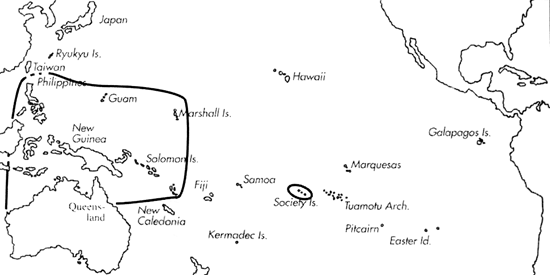Range: Moluccas and Philippines to Marshall Is. and to Solomon Is. and Vanuatu; probably in Society Is.
Description: Moderately large to large, moderately solid to solid. Last whorl narrowly conoid-cylindrical to ventricosely conical, sometimes narrowly conical; outline varies from almost straight to almost evenly convex, adapical fourth usually convex. Aperture wider at base than near shoulder. Shoulder angulate to rounded. Spire usually of moderate height, outline straight to domed. Larval shell of about 3.5 whorls, maximum diameter about 0.8 mm. First 3-5 postnuclear whorls tuberculate. Teleoconch sutural ramps convex to slightly concave, with 2-3 increasing to 4 spiral grooves, usually faint in latest whorls. Last whorl with equidistant spiral ribs, often weak above centre and sometimes with fine granules.
| Shell Morphometry | ||
|---|---|---|
| L | 55-100 mm | |
| RW | 0.17-0.70 g/mm | |
| (L 55-90 mm) | ||
| RD | 0.44-0.57 | |
| PMD | 0.71-0.86 | |
| RSH | 0.10-0.19 | |
Ground colour white, variably suffused with yellow or violet. Last whorl with light brown spiral bands, varying in number and width but usually leaving one ground colour band below centre. Shells with a plain banding pattern intergrade with speckled shells with darker brown blotches, with spiral rows of alternating white and dark brown dots, spots and dashes and sometimes with additional brown spiral lines. Rows of alternating dark and light markings usually diminish during growth, dark flecks and blotches do so sometimes. Base yellow or yellowish orange. Larval whorls white. Early teleoconch sutural ramps immaculate white; later ramps with brown axial markings, becoming darker but smaller and often sparse during growth. Aperture white or pale violet.
Periostracum pale yellow, thin, translucent and smooth, becoming yellowish brown, thicker, almost opaque and slightly velvety in large adults; in life, periostracum reported to be orange to rust red (Granger, 1981).
Dorsum of foot white to pink, mottled with brown or heavily speckled with brown and red, and paler posterior end immaculate. Sole of foot pink, grading to white posteriorly. Rostrum white proximally, tan distally. Tentacles white, tipped with brown. Siphon white to grey, mottled with brown; in juveniles, tip sometimes dark grey (Chaberman, pers. comm., 1981; Pearson, unpubl. observ.; de Couet, unpubl. observ.). Foot reported to be orange or rust red in E. New Britain (Richards, pers. comm., 1988).
Habitat and Habits: In 4-200 m; in sand, coral rubble, clefts of coral reefs or on lagoon pinnacles, beneath dead coral rocks; also reported on shipwrecks and steep cliffs of the fore-reef (Papua New Guinea; Chaberman, pers. comm., 1981; Richards, pers. comm., 1988).
Discussion: C. circumcisus is sometimes similar to C. aurisiacus; for the distinctions see the DISCUSSION of the latter species. Shells of C. circumcisus lacking the spiral rows of alternating brown and white maculae also resembling C. fulmen, which can be distinguished by its broader, consistently ventricosely conical last whorl (RD 0.55-0.62) and its orange-red instead of white apex. In addition, the brown blotches are darker in C. fulmen, with a less regular arrangement on the sutural ramps. C. laevis, with large reddish brown blotches, and C. brazieri (Pl. 16 Figs. 24, 26) with reduced pattern, are colour forms of C. circumcisus.

C. circumcisus range map
This section contains verbatim reproductions of the accounts of 316 species of Conus from the Indo-Pacific region, from Manual of the Living Conidae, by Röckel, Korn and Kohn (1995). They are reproduced with the kind permission of the present publisher, Conchbooks.
All plates and figures referred to in the text are also in Röckel, Korn & Kohn, 1995. Manual of the Living Conidae Vol. 1: Indo-Pacific Region.
The range maps have been modified so that each species account has it own map, rather than one map that showed the ranges of several species in the original work. This was necessary because each species account is on a separate page on the website and not confined to the order of accounts in the book.